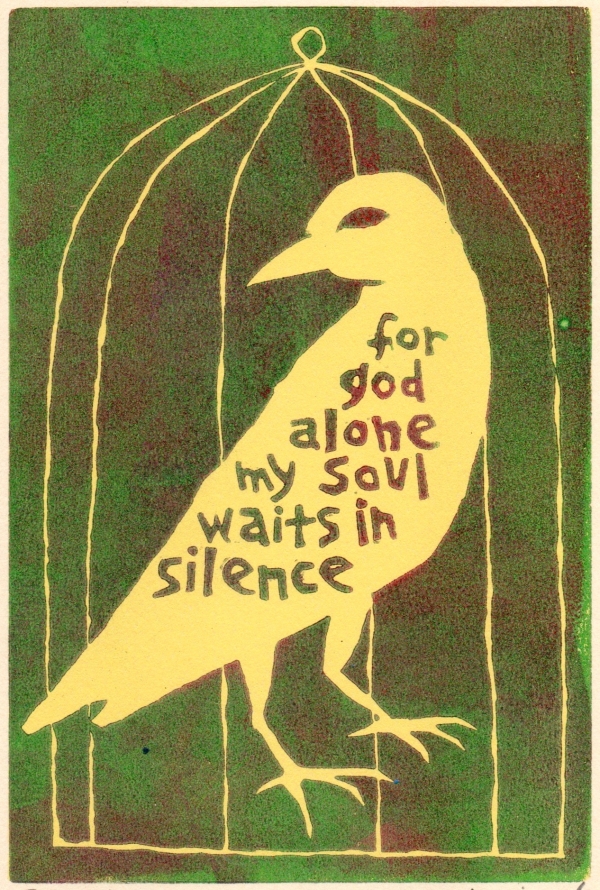Psalms Visualized: Artist Statement

Artist Statement
In the Beginning
Over the years I’ve become familiar with many beautifully hand-painted psalters from the Middle Ages, as well as woodcuts used to illustrate books of Psalms. However, in all of my research I have yet to turn up one entire book of Psalms illuminated entirely by woodcuts. This is somewhat surprising, because printmaking, especially in the 15th and 16th Centuries, was often used for thematic cycles, most notably The Passion of Christ and The Dance of Death (Ars moriendi, or The Art of Dying).
This intrigued me and was the impetus for undertaking such a project, and so I began my series, Psalms in 150 Block Prints, in January of 2008 with the intention of finishing it by year’s end. It was a side project to my other duties — making a commercially viable art so as to feed my family and pay bills. The Psalms proved much more difficult than expected, predominantly because they were not narrative in nature like the parables, a series I had completed a few years earlier. However, the Psalms did offer poetic similes, metaphors, and visual language that allowed my imagination to wander. Needless to say, the year came and went, was followed by another, and then another. My discipline on the project waned, but not my desire.
For me, the Psalms, as difficult as they were to read and interpret, became a devotional, my artwork a prayer. And so I trudged ahead, the project becoming more than the finished end, the journey more important than the destination.
The Monk Within
During the early Monastic movement, a time when few could read, monks would gather together around the abbot during the reading of the Scriptures. An emphasis was placed on memorization, as well as spiritual transformation — not just engaging the Word for knowledge but for life change. As a result, monks would listen carefully and allow a passage of Scripture to speak to them. St. Benedict incorporated this practice into his “Rule for Monks,” a prayer method that would come to be known as “Lectio Divina” (“Divine Reading”). The process required four stages: reading, meditating, praying, and contemplating. My approach to the Psalms was very similar to “Lectio Divina.”
Honey from the Comb
I felt I was unable to do the entire Psalms justice pictorially, especially since I was using such a small format (the actual images are 6” x 4”), so I took a smaller bit, sometimes just a sentence or two to use as inspiration for an image. This little sound bite, so to speak, also had a name and was used by Christians well before St. Benedict’s time. It was known as Meletē.
In his book Desert Banquet, author David Keller writes, “[Meletē] is the practice of repeating a verse or short phrase throughout the day, usually aloud. The desert elders used meletē for “continual awareness of God” in the midst of distractions caused by “every kind of thought” and “all bodily cares and concerns.” This simple practice, done silently or aloud at different times, can help us remain centered on God’s presence in the midst of distractions and responsibilities that consume our attention. The “formula” reminds us to always seek God’s help, and that we are never without God’s presence. The practice destroys the myth that there is not enough time in the day for meditation. It enables us to pause several times each day to become mindful of what is most fundamental in life.
Spiritual director Margaret Self writes about this type of prayerful reading as taking a “piece of chocolate” with you through the day to chew, taste, and savor. It was with this idea that I often began my day. I knew as I “chewed” on a line from the Psalms that I would find it much more nourishing than an empty calorie of chocolate.
My intention was not just to illustrate the Psalms in historic imagery but to find aspects of these songs that spoke to me in the here and now. My love of reading took me through many commentaries, as well as books on Christian signs and symbols. As a result, viewers of my work will see alongside my own visual language symbols that have been used in Christian art for centuries. For example, the “eye of God,” which is a part of early Medieval and Renaissance Christian art, is depicted throughout my book Psalms in 150 Block Prints and, in fact, becomes a staple suggesting the omnipresence and sovereignty of God. The ever-present gaze of God is stated through the psalmist’s observation, “The eyes of the Lord are on the righteous, and his ears are attentive to their cry.”
A Visual Language
The psalmist is very descriptive of God, giving him eyes and eyelids, ears, nostrils, mouth, feet, hands, arms and wings, among other things. God holds a rod and staff, and shoots His weapon of war, the bow and arrow. The psalmist goes on to describe Him like a mountain, a rock, a shield, a hiding place, a father, a shepherd, a warrior, and even a drunkard rising from slumber!
I take advantage of this language, using visual metaphors to often mirror the writer’s poetry. For example, Psalm 17 depicts a one-eyed bird with the words, “Keep me as the apple of your eye; hide me in the shadow of your wings.” To think that God is a one-eyed bird is rather silly and naïve; thus, the viewer must deduce that this visual metaphor stands for certain attributes of God, in this case, that of a caretaker and a protector.
Another example is the monk who, praying the Psalms seven times a day through what is called the “Daily Office” or canonical hours, is depicted as a spiritual seeker of truth and a practicing disciple.
The Messiah
It was Patrick Henry Reardon’s book Christ in the Psalms that awakened me to how prophetic the Psalms really are: Jesus didn’t merely pray the Psalter, he lived it! Christ’s statement in the Gospel of Luke, “Everything must be fulfilled that is written about me in the . . . Psalms[,]” forced me to rethink and reexamine every aspect of this text. We are given insight into events that would eventually occur, and even deeper visual elements that don’t appear in the Gospels themselves.
Physical to Spiritual
The Psalms were written during a different culture and time. There is a ferocious intensity when it comes to hating one’s enemies. And although these are very real and raw emotions that continue with us today, the direction has shifted. Jesus rebukes his disciples who wish to call down fire from heaven on their enemies. He challenges them to an even greater amount of love when he gives them a new commandment: to love one’s neighbor as he has loved them! This calls them to serve, love, and even die for their enemies.
In St. Paul’s letter to the Ephesians, he writes, “For our struggle is not against flesh and blood, but against the rulers, against authorities, against the powers of this dark world and against the spiritual forces of evil in the heavenly realms.” If this is true, then the warrior-psalmist’s cry, “Happy is the one who seizes your infants and dashes them against the rocks (Ps 137:9)”, forces me to confront those sinful attitudes, hurtful words, and other aspects of my life that begin to creep in that are contrary to the love of Christ.
Even though this military terminology is now spiritual, I depict it visually, as if it were still physical.
Visio Divina
Both music and pictures help me to recall, memorize, and internalize. The longer I’ve lived with these images, the easier it has become to identify certain Psalms. Basically, the Psalms in 150 Block Prints are my own contemporary psalter or prayer book. I hope you enjoy them and find meaning and enlightenment through them as you continue on your own journey onward and upward.
